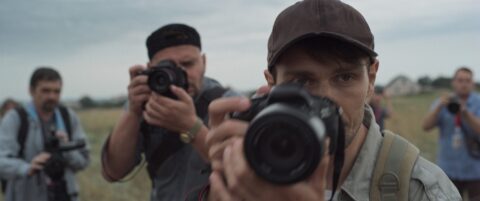The mayor, bearing a striking resemblance to a bed-bound Bolsonaro, is in a coma. To make up for his lack of physical presence in the upcoming elections, his campaign team have shoddily deep-faked a video of his face on top of another man, awkwardly dancing in the hope of going viral. Set in 2021 — a couple of years before AI became eerily precise — the video is obviously completely fake. But it doesn’t matter if people believe it. The pretence of democracy is enough.
A shaggy-dog story bursting with ideas and concepts, Roman Bondarchuk’s journalism satire The Editorial Office (2024) is filled with grimfunny moments like these, tackling the concept of fake news and its relation to institutional corruption while fully dialling up the comic absurdity. Focussing on a young researcher named Yuri (Dmytro Bahnenko) searching for a groundhog in Southern Ukraine before stumbling into a city-wide conspiracy, its black comic tone feels all the more dark in light of the Russian full-scale invasion to come.
Bondarchuk treads a careful line between outright satire — and expertly staged comedy beats (including a gang war between funeral directors and a variety of hilarious cameos at the very end) — and lesson time, with more than one character giving Yuri a lesson in the futility of holding the powerful to account. This is especially true when he tries to make a difference at his city’s local newspaper, only to be told that people only care about sensationalist stories with a bit of eroticism thrown in (like a woman falling from a balcony and losing all her clothes in the process.) Yet, with a more arthouse approach to camerawork and blocking than a traditional comedy — with complex, multi-layered takes, and plenty of alienating medium and long-distance shots — the satirical elements can be lost amidst all the weighty ambition.
The lead actor Bahnenko is a journalist himself, known for his brave work filming in Kherson under Russian occupation, creating an in-the-moment testimony to the horrors of the Putin regime. It’s a bold appearance: witnessing the worst of the invading force, then using his role here to acknowledge Ukraine’s ongoing internal issues.
Yet despite this lived-in aspect, his character is remarkably passive, making him an excellent observer of the various goings-on, but a difficult protagonist to hold onto for the better part of two hours. It makes for a strange and difficult film, one that’s easy to talk and think about for ages, while lacking the necessary edge to let its message sink in.
Still, it’s remarkable that the Ukrainian state funds such a self-reflective film in the middle of a war. While the nation might have a long way to go before the chaos (both internal and external) ends, this high level of self-awareness can only be a good thing.
Redmond is the editor-in-chief of Journey Into Cinema.

